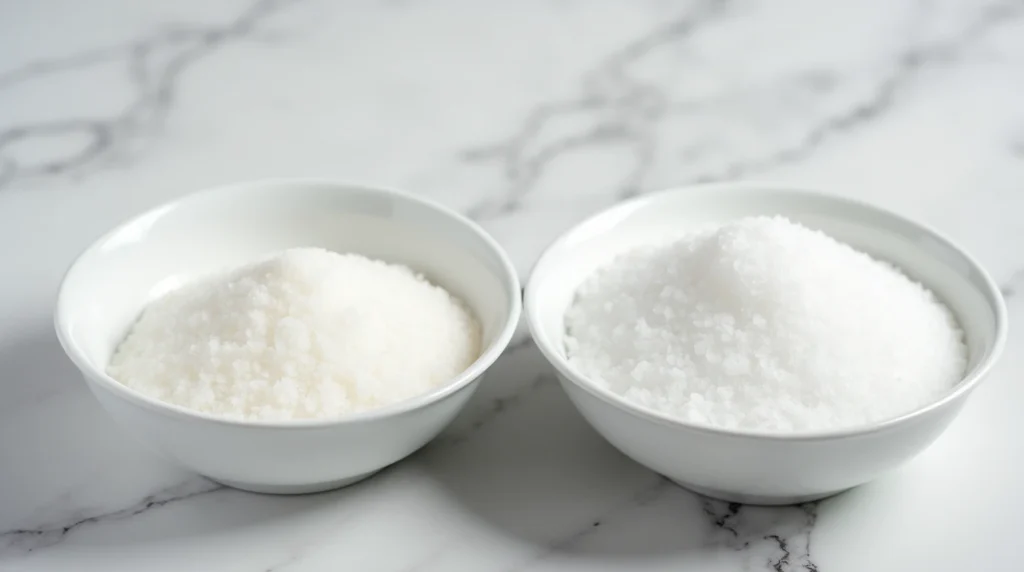Introduction to Caster Sugar
Occupying the middle ground between standard granulated and powdered varieties, caster sugar (called superfine sugar by Americans) features distinctively smaller crystals that offer unique culinary advantages. The name “caster” comes from the era when sugar was dispensed through a “caster” or shaker with perforations. This specialized sugar plays a crucial role in baking and cooking, particularly in recipes requiring sugar to dissolve quickly and seamlessly.
While many home bakers may not keep caster sugar as a pantry staple, professional chefs and bakers consider it essential for achieving perfect results in delicate desserts like meringues, mousses, and soufflés. Its fine crystal structure allows it to incorporate air more effectively when creamed with butter, resulting in lighter, fluffier baked goods.
The Origin Story of Caster Sugar

The history of caster-sugar is intertwined with the evolution of sugar refining techniques. Sugar itself has a rich global history dating back thousands of years. Initially cultivated in New Guinea around 8000 BCE, sugar cane spread to India, where techniques for extracting and crystallizing sugar were developed around 350 CE.
By the medieval period, sugar had become a luxury commodity in Europe. The refinement process advanced significantly during the Industrial Revolution when more sophisticated methods allowed for creating different sugar grades. Caster-sugar emerged as manufacturers developed techniques to produce more finely ground sugar for specific culinary applications.
In Britain, where the term “caster-sugar” is most commonly used, it became particularly popular during the Victorian era when elaborate desserts and fine baking became fashionable. The ability to produce consistently fine sugar crystals revolutionized baking, allowing for more delicate textures in pastries and confections.
Today, caster-sugar remains a staple in professional kitchens worldwide, though it goes by different names depending on the region—superfine sugar in America, berry sugar in Canada, and baker’s sugar in some parts of Europe.
Can You Blend Regular Sugar to Make Caster Sugar?
Yes, you can effectively blend regular granulated sugar to create a homemade version of caster sugar. This question expands on the method described bellow but deserves special attention because it’s such a common query.
A food processor or high-powered blender will work best for this task. The goal is to break down the larger crystals of granulated sugar into smaller, finer particles without pulverizing them into powder. Most home cooks find that 30-60 seconds of processing is sufficient, though this may vary depending on your equipment.
There are some important considerations when making your own caster-sugar:
- Process in smaller batches for more consistent results
- Use short pulses rather than continuous blending
- Let the sugar dust settle before opening your appliance
- Sift the processed sugar if you need very consistent results
While commercial caster-sugar undergoes a more controlled production process, homemade versions work remarkably well in most recipes. The main difference is that commercial caster-sugar typically has a more uniform crystal size.
How to Make Caster Sugar from Normal Sugar?
Creating caster-sugar at home is surprisingly simple. If you find yourself in the middle of a recipe calling for caster-sugar without any on hand, you can easily make a substitute using regular granulated sugar:
- Measure the amount of granulated sugar needed for your recipe.
- Place the granulated sugar in a food processor or blender.
- Pulse in short bursts for about 1-2 minutes, stopping occasionally to check the consistency.
- Avoid over-processing, which can turn the sugar into powdered sugar.
- Allow the sugar to settle for a few minutes before opening the processor to prevent a sugar cloud.
- Use immediately or store in an airtight container.
The key is to process the sugar just enough to create finer crystals without turning it into powder. This homemade version won’t be as uniformly fine as commercial caster sugar, but it works well as a substitute in most recipes.
Why Is Caster Sugar So Expensive?
Caster-sugar typically comes with a higher price tag than regular granulated sugar for several reasons:
- Production Process: Creating uniformly fine crystals requires additional processing steps and specialized equipment.
- Supply and Demand: In some regions, especially the United States where it’s less commonly used, lower production volumes lead to higher prices.
- Packaging Costs: Caster-sugar often comes in smaller, more specialized packaging, increasing the per-unit cost.
- Marketing Positioning: It’s often marketed as a premium or specialty product, allowing manufacturers to command higher prices.
- Import Costs: In countries where it’s not widely produced, import duties and transportation costs add to the retail price.
The price difference can be substantial, sometimes 50-100% more than regular granulated sugar. For budget-conscious bakers, making your own caster-sugar from granulated sugar represents significant savings, especially for recipes requiring large quantities.
How Healthy Is Caster Sugar?
From a nutritional standpoint, caster-sugar is essentially identical to regular granulated sugar. The processing affects only the crystal size, not the fundamental nutritional profile. Like all refined sugars, caster-sugar:
- Contains approximately 4 calories per gram
- Provides no significant vitamins, minerals, or fiber
- Is primarily composed of sucrose (a disaccharide of glucose and fructose)
- Has a high glycemic index, causing rapid blood sugar spikes
Health organizations worldwide recommend limiting added sugar intake. Health experts at the American Heart Association advise limiting sugar consumption to just 9 teaspoons (36g) daily for males and a more restricted 6 teaspoons (25g) for females to maintain optimal wellness.
Excessive sugar consumption has been linked to numerous health concerns including obesity, type 2 diabetes, heart disease, and dental problems. The World Health Organization reinforces these concerns with similar guidelines on limiting added sugar intake.
For more detailed information about sugar’s health impacts, refer to the comprehensive research published by Harvard T.H. Chan School of Public Health at https://www.hsph.harvard.edu/nutritionsource/carbohydrates/added-sugar-in-the-diet/.
Caster Sugar vs. Granulated Sugar
Understanding the differences between caster sugar and granulated sugar helps determine which is most appropriate for specific recipes:
| Characteristic | Caster Sugar | Granulated Sugar |
|---|---|---|
| Crystal Size | Fine, uniform particles | Larger, more irregular crystals |
| Dissolution Rate | Dissolves quickly | Dissolves more slowly |
| Texture in Baking | Creates finer crumb in cakes | Can produce coarser texture |
| Air Incorporation | Superior for creaming with butter | Less effective for aeration |
| Visual Appearance | Appears smoother in finished products | May leave visible crystals |
| Best Uses | Meringues, mousses, delicate baking | General sweetening, sturdy baked goods |
The finer texture of caster sugar makes it superior for recipes where sugar needs to dissolve quickly without heat, such as cold beverages, uncooked frostings, or delicate desserts like meringues. Everyday cooking and baking recipes typically work wonderfully with standard granulated sugar, which continues to be a reliable and versatile sweetening option in most kitchen applications.
Where Can I Buy Caster Sugar?
Caster sugar is available through several purchasing channels:
- Supermarkets and Grocery Stores: Look in the baking aisle, though availability varies by region. In the UK and Australia, it’s widely available; in the US, it may be labeled as “superfine” or “baker’s sugar.”
- Specialty Baking Shops: Stores specializing in baking supplies reliably stock caster-sugar.
- Online Retailers: Amazon, King Arthur Baking Company, and other online grocers offer caster-sugar with home delivery.
- Bulk Food Stores: Some bulk food retailers sell caster-sugar at competitive prices.
- International Food Sections: In countries where it’s less common, check international food aisles, particularly those featuring British products.
Popular brands include C&H, Domino (sold as “Superfine”), Tate & Lyle, and Silver Spoon. Prices typically range from $3-$7 per pound, depending on brand and location.
If you can’t find caster-sugar locally, remember that making your own from granulated sugar is a convenient and cost-effective alternative.
Frequently Asked Questions About Caster Sugar
1. Is caster sugar the same as powdered sugar?
No. Caster-sugar has finer crystals than granulated sugar but is still crystalline, while powdered sugar (confectioners’ sugar) is ground to a powder and typically contains anti-caking agents like cornstarch.
2. Can I substitute caster sugar with other sugars?
While caster-sugar has its specific uses, ordinary granulated sugar serves as an effective replacement in the majority of dishes, with only subtle textural differences in the final result. For recipes where quick dissolution is crucial, processing granulated sugar creates an effective substitute.
3. Does caster sugar affect the flavor of baked goods differently?
The flavor is identical to regular sugar, but the finer texture can create a more even distribution of sweetness and improved texture in delicate baked goods.
4. How should I store caster sugar?
Store in an airtight container in a cool, dry place. Properly stored, it has an indefinite shelf life.
5. Why do meringue recipes specifically call for caster sugar?
The fine crystals dissolve more quickly and completely into egg whites, creating a stable, smooth meringue without grittiness.
6. Is organic caster sugar available?
Yes, several brands offer organic options, though they typically come at a premium price.
7. Does caster sugar have any advantages in cold beverages?
Yes, it dissolves much more readily in cold liquids, making it ideal for cocktails, iced tea, and other cold drinks.
8. Is caster-sugar suitable for diabetics?
No, caster-sugar affects blood glucose levels the same way as regular sugar and should be limited or avoided by people with diabetes.
9. How does caster-sugar perform in recipes requiring caramelization?
It caramelizes more quickly and evenly than granulated sugar due to its smaller crystal size, requiring careful monitoring to prevent burning.
10. Can caster-sugar be used in savory recipes?
Yes, its quick-dissolving properties make it useful in glazes, marinades, and other savory applications where smooth incorporation is desirable.Retry
May Be Loved It

